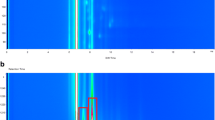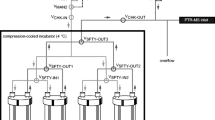Abstract
A new approach is introduced for rapid and reliable bacteria detection in food. Namely, static headspace-comprehensive two-dimensional gas chromatography (HS-GC × GC) with backflushing. The introduced approach provides fast detection of Escherichia coli (E. coli) in enriched ultra-high-temperature processed (UHT) dairy milk. The presence of E. coli may be indicated by detecting microbial volatile organic compounds emanating from test solutions inoculated with E. coli. In the present investigation, HS-GC × GC analysis is preceded by conventional enrichment in nutrient broth and inoculated samples are clearly discernable from controls following as little as 15 h sample enrichment. Headspace equilibration for 28 min followed by an 8 min GC × GC analysis of enriched test solutions reduces time-to-response by approximately one full day compared to conventional culture-based methods. The presence of ethanol, 1-propanol, and acetaldehyde may be used as a putative marker of E. coli contamination in milk and the introduced approach is able to detect single-cell initial bacterial load. Faster, reliable detection of pathogens and/or spoilage microbes in food products is desirable for the food industry. The described approach has great potential to complement the conventional workflow and be utilised for rapid microbial screening of foodstuff.




Similar content being viewed by others
References
World Health Organization. WHO estimates of the global burden of foodborne diseases. World Health Organization. 2015. https://apps.who.int/iris/handle/10665/199350. Accessed 15 July 2022.
Food Standards Australia New Zealand. Food recall statistics. 2022. https://www.foodstandards.gov.au/industry/foodrecalls/recallstats/pages/default.aspx. Accessed 17 Aug 2022.
Wittenberger K, Dohlman E. Peanut outlook: impacts of the 2008–09 foodborne illness outbreak linked to Salmonella in peanuts. Economic Research Service. 2010. https://www.ers.usda.gov/publications/pub-details/?pubid=37836. Accessed 17 July 2022.
Ferone M, Gowen A, Fanning S, Scannell AGM. Microbial detection and identification methods: bench top assays to omics approaches. Compr Rev Food Sci. 2020. https://doi.org/10.1111/1541-4337.12618.
Zhao X, Lin C-W, Wang J, Oh DH. Advances in rapid detection methods for foodborne pathogens. J Microbiol Biotechnol. 2014. https://doi.org/10.4014/jmb.1310.10013.
Xu Y, Cheung W, Winder CL, Goodacre R. VOC-based metabolic profiling for food spoilage detection with the application to detecting Salmonella typhimurium-contaminated pork. Anal Bioanal Chem. 2010. https://doi.org/10.1007/s00216-010-3771-z.
Jadhav SR, Shah RM, Karpe AV, Morrison PD, Kouremenos K, Beale DJ, Palombo EA. Detection of foodborne pathogens using proteomics and metabolomics-based approaches. Front Microbiol. 2018. https://doi.org/10.3389/fmicb.2018.03132.
Bhattacharjee P, Panigrahi S, Lin D, Logue CM, Sherwood JS, Doetkott C, Marchello M. A comparative qualitative study of the profile of volatile organic compounds associated with Salmonella contamination of packaged aged and fresh beef by HS-SPME/GC-MS. J Food Sci Technol. 2011. https://doi.org/10.1007/s13197-010-0138-6.
Carraturo F, Libralato G, Esposito R, Galdiero E, Aliberti F, Amoresano A, Fontanarosa C, Trifuoggi M, Guida M. Metabolomic profiling of food matrices: preliminary identification of potential markers of microbial contamination. J Food Sci. 2020. https://doi.org/10.1111/1750-3841.15418.
Beale DJ, Morrison PD, Palombo EA. Detection of Listeria in milk using non-targeted metabolic profiling of Listeria monocytogenes: a proof-of-concept application. Food Control. 2014. https://doi.org/10.1016/j.foodcont.2014.01.022.
Chen J, Tang J, Shi H, Tang C, Zhang R. Characteristics of volatile organic compounds produced from five pathogenic bacteria by headspace-solid phase micro-extraction/gas chromatography-mass spectrometry. J Basic Microbiol. 2017. https://doi.org/10.1002/jobm.201600505.
Wang Y, Liu S, Pu Q, Li Y, Wang X, Jiang Y, Yang D, Yang Y, Yang J, Sun C. Rapid identification of Staphylococcus aureus, Vibrio parahaemolyticus and Shigella sonnei in foods by solid phase microextraction coupled with gas chromatography–mass spectrometry. Food Chem. 2018. https://doi.org/10.1016/j.foodchem.2018.04.088
Antolak H, Jeleń H, Otlewska A, Kręgiel D. Volatile compounds associated with growth of Asaia bogorensis and Asaia lannensis-unusual spoilage bacteria of functional beverages. Food Res. Int. 2019. https://doi.org/10.1016/j.foodres.2019.03.054
Wen R, Kong B, Yin X, Zhang H, Chen Q. Characterisation of flavour profile of beef jerky inoculated with different autochthonous lactic acid bacteria using electronic nose and gas chromatography–ion mobility spectrometry. Meat Sci. 2022. https://doi.org/10.1016/j.meatsci.2021.108658.
Siripatrawan U, Harte BR. Solid phase microextraction/gas chromatography/mass spectrometry integrated with chemometrics for detection of Salmonella typhimurium contamination in a packaged fresh vegetable. Anal Chim Acta. 2007. https://doi.org/10.1016/j.aca.2006.08.007.
Cevallos-Cevallos JM, Danyluk MD, Reyes-De-Corcuera JI. GC-MS based metabolomics for rapid simultaneous detection of Escherichia coli O157: H7, Salmonella Typhimurium, Salmonella Muenchen, and Salmonella Hartford in ground beef and chicken. J Food Sci. 2011. https://doi.org/10.1111/j.1750-3841.2011.02132.x.
Hossain SMZ, Bojko B, Pawliszyn J. Automated SPME–GC–MS monitoring of headspace metabolomic responses of E. coli to biologically active components extracted by the coating. Anal Chim Acta. 2013; https://doi.org/10.1016/j.aca.2013.03.018
Ubeda C, Callejón RM, Hidalgo C, Torija MJ, Mas A, Troncoso AM, Morales ML. Determination of major volatile compounds during the production of fruit vinegars by static headspace gas chromatography–mass spectrometry method. Food Res Int. 2011. https://doi.org/10.1016/j.foodres.2010.10.025.
Zhang R, Tang C, Jiang B, Mo X, Wang Z. Optimization of HS-SPME for GC-MS analysis and its application in characterization of volatile compounds in sweet potato. Molecules. 2021. https://doi.org/10.3390/molecules26195808.
Aliferis KA, Tarantilis PA, Harizanis PC, Alissandrakis E. Botanical discrimination and classification of honey samples applying gas chromatography/mass spectrometry fingerprinting of headspace volatile compounds. Food Chem. 2010. https://doi.org/10.1016/j.foodchem.2009.12.098.
Strączyński G, Ligor T. Comprehensive gas chromatography: food and metabolomocs applications, Crit Rev Anal Chem. 2018; https://doi.org/10.1080/10408347.2017.1390426
Fang S, Liu S, Song J, Huang Q, Xiang Z. Recognition of pathogens in food matrixes based on the untargeted in vivo microbial metabolite profiling via a novel SPME/GC × GC-QTOFMS approach. Food Res Int. 2021. https://doi.org/10.1016/j.foodres.2021.110213.
Wang W, Feng X, Zhang D, Li B, Sun B, Tian H, Liu Y. Analysis of volatile compounds in Chinese dry-cured hams by comprehensive two-dimensional gas chromatography with high-resolution time-of-flight mass spectrometry. Meat Sci. 2018. https://doi.org/10.1016/j.meatsci.2018.02.016.
Zhang L, Zeng Z, Zhao C, Kong H, Lu X, Xu G. A comparative study of volatile components in green, oolong and black teas by using comprehensive two-dimensional gas chromatography–time-of-flight mass spectrometry and multivariate data analysis. J Chromatogr A. 2013. https://doi.org/10.1016/j.chroma.2013.06.022.
Bean HD, Dimandja J-MD, Hill JE. Bacterial volatile discovery using solid phase microextraction and comprehensive two-dimensional gas chromatography-time-of-flight mass spectrometry. J Chromatogr B Analyt Technol Biomed Life Sci. 2012. https://doi.org/10.1016/j.jchromb.2012.05.038
Aparicio-Ruiz R, García-González DL, Morales MT, Lobo-Prieto A, Romero I. Comparison of two analytical methods validated for the determination of volatile compounds in virgin olive oil: GC-FID vs GC-MS. Talanta. 2018. https://doi.org/10.1016/j.talanta.2018.05.008.
Pawliszyn J. Applications of solid phase microextraction. Cambridge: Royal Society of Chemistry; 2007.
Garcia-Esteban M, Ansorena D, Astiasarán I, Ruiz J. Study of the effect of different fiber coatings and extraction conditions on dry cured ham volatile compounds extracted by solid-phase microextraction (SPME). Talanta. 2004. https://doi.org/10.1016/j.talanta.2004.03.007.
Merkle S, Kleeberg KK, Fritsche J. Recent developments and applications of solid phase microextraction (SPME) in food and environmental analysis—a review. Chromatography. 2015. https://doi.org/10.3390/chromatography2030293.
Kolb B, Ettre LS. Static headspace-gas chromatography: theory and practice. 2nd ed. New Jersey: John Wiley & Sons; 2006.
Food Safety and Inspection Service. Lakeside refrigerated services recalls ground beef products due to possible E. coli O103 contamination. 2022. http://www.fsis.usda.gov/recalls-alerts/lakeside-refrigerated-services-recalls-ground-beef-products-due-possible-e--coli. Accessed 8 Nov 2022.
Public Health Agency of Canada. Public health notice: outbreak of E. coli infections linked to Hankook (korean characters only) brand original kimchi. 2022. https://www.canada.ca/en/public-health/services/public-health-notices/2022/outbreak-e-coli-infections-linked-handkook-brand-original-kimchi.html. Accessed 8 November 2022.
Desk N. E. coli prompts milk recall in Australian states. 2020. https://www.foodsafetynews.com/2020/02/e-coli-prompts-milk-recall-in-australian-states/. Accessed 8 November 2022.
United States Food and Drug Administration. Outbreak of E. coli infections linked to romaine lettuce. 2019. https://www.cdc.gov/ecoli/2018/o157h7-11-18/index.html. Accessed 8 Nov 2022.
Herigstad B, Hamilton M, Heersink J. How to optimize the drop plate method for enumerating bacteria. J Microbiol Methods. 2001. https://doi.org/10.1016/S0167-7012(00)00241-4.
Seeley JV, Micyus NJ, Bandurski SV, Seeley SK, McCurry JD. Microfluidic deans switch for comprehensive two-dimensional gas chromatography. Anal Chem. 2007. https://doi.org/10.1021/ac061881g.
Guan X, Luong J, Yu Z, Jiang H. Quasi-stop-flow modulation strategy for comprehensive two-dimensional gas chromatography. Anal Chem. 2020. https://doi.org/10.1021/acs.analchem.0c00814.
Luong J, Guan X, Xu S, Gras R, Shellie RA. Thermal independent modulator for comprehensive two-dimensional gas chromatography. Anal Chem. 2016; https://doi.org/10.1021/acs.analchem.6b02525
Klee MS. Optimizing capillary column backflush to improve cycle time and reduce column contamination. J Sep Sci. 2009. https://doi.org/10.1002/jssc.200800434.
Sohrabi M, Zhang L, Kai Z, Ahmetagic A, Wei MQ. Volatile organic compounds as novel markers for the detection of bacterial infections. Clin Microbiol. 2014. https://doi.org/10.4172/2327-5073.1000151.
Arnold JW, Senter SD. Use of digital aroma technology and SPME GC-MS to compare volatile compounds produced by bacteria isolated from processed poultry. J Sci Food Agric. 1998. https://doi.org/10.1002/(SICI)1097-0010(199811)78:3%3C343::AID-JSFA124%3E3.0.CO;2-5.
Zhu J, Bean HD, Kuo Y-M, Hill JE. Fast detection of volatile organic compounds from bacterial cultures by secondary electrospray ionization-mass spectrometry. J Clin Microbiol. 2010. https://doi.org/10.1128/JCM.00392-10.
Miyake T, Shibamoto T. Quantitative analysis of acetaldehyde in foods and beverages. J Agric Food Chem. 1993. https://doi.org/10.1021/jf00035a028.
Förster AH, Gescher J. Metabolic engineering of Escherichia coli for production of mixed-acid fermentation end products. Front Bioeng Biotechnol. 2014. https://doi.org/10.3389/fbioe.2014.00016.
Acknowledgements
The authors acknowledge generous support from Trajan Scientific and Medical.
Funding
Wan Sin Heng is the recipient of a Deakin University Postgraduate Research Scholarship. Maiken Ueland is the recipient of an Australian Research Council Discovery Early Career Award (project number DE210100494) funded by the Australian Government.
Author information
Authors and Affiliations
Corresponding author
Ethics declarations
Competing interests
The authors declare no competing interests.
Additional information
Publisher's note
Springer Nature remains neutral with regard to jurisdictional claims in published maps and institutional affiliations.
Published in the topical collection Comprehensive 2D Chromatography with guest editors Peter Q. Tranchida and Luigi Mondello.
Supplementary Information
Below is the link to the electronic supplementary material.
Rights and permissions
Springer Nature or its licensor (e.g. a society or other partner) holds exclusive rights to this article under a publishing agreement with the author(s) or other rightsholder(s); author self-archiving of the accepted manuscript version of this article is solely governed by the terms of such publishing agreement and applicable law.
About this article
Cite this article
Heng, W.S., Jadhav, S.R., Ueland, M. et al. Rapid detection of Escherichia coli in dairy milk using static headspace-comprehensive two-dimensional gas chromatography. Anal Bioanal Chem 415, 2535–2545 (2023). https://doi.org/10.1007/s00216-022-04485-7
Received:
Revised:
Accepted:
Published:
Issue Date:
DOI: https://doi.org/10.1007/s00216-022-04485-7




